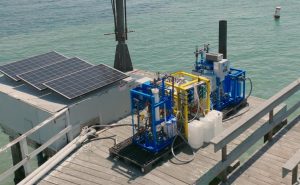Evaluation of carbon dioxide removal technology to shed light on possible solution for climate change

SCCWRP and its partners have begun working to evaluate the effectiveness of a technology designed to remove dissolved carbon dioxide directly from coastal waters – an investigation that will shed light on whether this potential management solution could help combat global climate change as well as alleviate the effects of intensifying West Coast ocean acidification.
In July, SCCWRP began working with startup company Captura to examine if the company’s electrodialysis technology – known as direct ocean capture – has the potential to draw down carbon dioxide in the atmosphere by removing carbon dioxide from coastal waters. Captura’s technology uses renewable energy to isolate and trap dissolved carbon dioxide so it can be stored or reused.
Captura’s working hypothesis is that carbon dioxide removal will increase the waters’ capacity to absorb carbon dioxide from the atmosphere. The company hopes the water, in turn, will draw down carbon dioxide emissions in the atmosphere that are driving climate change.
SCCWRP will use the opportunity to explore whether Captura’s technology also has the potential to offset the ecological effects of ocean acidification in Southern California coastal waters. Ocean acidification is a consequence of the world’s ocean absorbing about a third of all atmospheric carbon dioxide emissions.
To assess whether Captura’s technology could achieve its goals if deployed in coastal waters, researchers will apply a computer model that was originally developed to predict the trajectory of ocean acidification and hypoxia (OAH) in coastal waters. Known as ROMS-BEC (Regional Ocean Modeling System + Biogeochemical Elemental Cycling), the modeling tool was developed by a team that includes SCCWRP.
Captura’s electrodialysis technology, which won an XPRIZE award in a carbon removal competition in 2022, was developed by a research team based at the California Institute of Technology (Caltech). The Los Angeles-based company wants to use the ROMS-BEC model to study the technology’s effectiveness in Southern California coastal waters.
Electrodialysis is one of multiple marine carbon dioxide removal (mCDR) technologies being investigated as potential solutions for the effects of climate change and coastal OAH. Other burgeoning mCDR technologies include ocean alkalinity enhancement, artificial upwelling and downwelling, and macroalgal farming.
For macroalgal farming – in which offshore kelp farms are used to promote removal of nutrients and carbon dioxide from surrounding waters – researchers are using the same ROMS-BEC model to investigate the potential effectiveness of this nature-based mCDR technology.
In evaluating all of these potential mCDR solutions, researchers are focusing on understanding the interplay between potential local management actions and the global trajectories at which climate change and ocean acidification are unfolding. The degree to which mCDR technologies can be scaled up and/or used in combination with other management solutions could play a pivotal role in mitigating and offsetting these dual consequences of rising atmospheric carbon dioxide emissions.
For more information, contact Dr. Christina Frieder.
More news related to: Climate Change, Ocean Acidification and Hypoxia, Top News